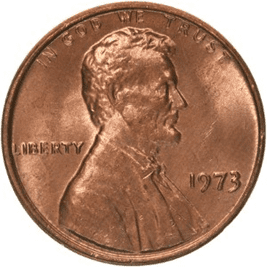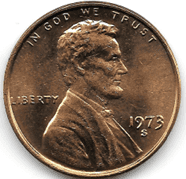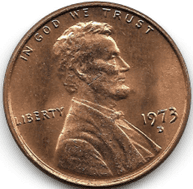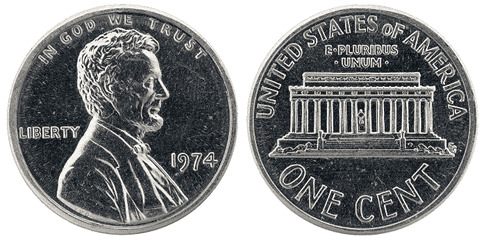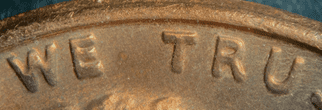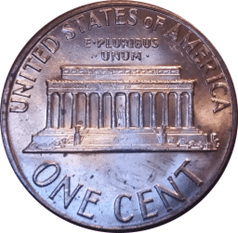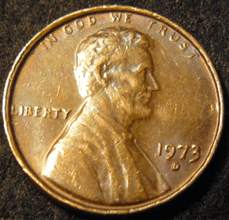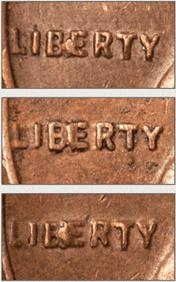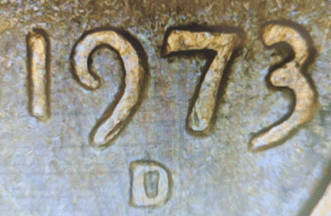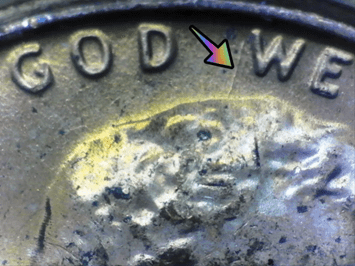How Rare Is A 1973 Penny?
In general, the 1973 Lincoln Penny isn’t a rare coin, and can still be found in pocket change. Unless it is a rare error coin, the value of the 1973 penny comes from its sentimental value. One of the most interesting characteristics of coins and coin collecting is that they can serve as a record of historical events that occurred during the year in question. They can also be used as a keepsake for someone who was born in that year or experienced an important life event at that time.
The biggest events of the year occurred in the political sector; President Richard Nixon is sworn in for a second term. Nixon is the only person to have been sworn in as President and Vice President of the United States twice (1969, 1973) and (1953, 1957), however, the beginning of what became known as the Watergate scandal was just around the corner. The United States Supreme Court overturns state abortion bans in Roe v. Wade. With the signing of the Paris Peace Accords, the United States’ involvement in the Vietnam War comes to an end.
Contents
1973 Penny Series
1) 1973 Penny With No Mint Mark
Year: 1973
Face Value: $0.01
Composition: 95% copper, 5% zinc
Total Weight: 3.11 grams (or over)
Diameter: 0.750 in. 19.05 mm
Thickness: 0.0598 inches (1.52 mm)
Edge: Plain
Minted in: Philadelphia
Quantity Minted : 3,728,245,000

photo source: www.silverrecyclers.com
2) 1973 S Penny
Year: 1973
Face Value: $0.01
Composition: 95% copper, 5% zinc
Total Weight: 3.11 grams (or over)
Diameter: 0.750 in. 19.05 mm
Thickness: 0.0598 inches (1.52 mm)
Edge: Plain
Minted in: San Francisco
Quantity Minted : 319,937,634

photo source: www.ebay.co.uk
3) 1973 D Penny
Year: 1973
Face Value: $0.01
Composition: 95% copper, 5% zinc
Total Weight: 3.11 grams (or over)
Diameter: 0.750 in. 19.05 mm
Thickness: 0.0598 inches (1.52 mm)
Edge: Plain
Minted in: Denver
Quantity Minted : 3,549,576,588

photo source: www.ebay.co.uk
4) 1973 Aluminum Penny
Year: 1973
Face Value: $0.01
Composition: 95% copper, 5% zinc
Total Weight: 3.11 grams (or over)
Diameter: 0.750 in. 19.05 mm
Thickness: 0.0598 inches (1.52 mm)
Edge: Plain
Minted in: Philadelphia
Quantity Minted : Unknown mintage of approximately 1.5 million

photo source: coinweek.com
How Much Is A 1973 Penny Worth Today?
The estimated mintage numbers and values of the various non-error varieties of the 1973 Lincoln penny are listed below. (The values of error coins can massively fluctuate, but we’ve provided price indicators in the entries above). The given prices are significantly dependent on the condition and grade of the item.
The official grading given, circulation numbers, any distinctive aspects about the coin (such as errors), the overall condition and wear, and whether or not the piece was actively used in circulation are all factors that influence the value of coins.
| Coin | Mintage | Value (Circulated) | Value (Uncirculated) | Highest Value Reported |
| 1973 No Mintmark (Philadelphia) | 3,728,245,000 | 2c+ | 10-30c+ | Professional Coin Grading Service graded the most valuable 1973 no mintmark cent ever sold as MS67+RD. It sold for $3,850 in a 2020 auction. |
| 1973-D (Denver) | 3,549,576,588 | 2c+ | 10-30c+ | Professional Coin Grading Service graded the most valuable 1973-D penny MS67RD, and it sold for $4,993.75 in a 2014 auction. |
| 1973-S (San Francisco) | 319,937,634 | 2c+ | 10-30c+ | Professional Coin Grading Service graded the most valuable 1973-S cent MS67RD, and it sold for $2,232.50 in a 2016 auction. |
| 1973/4 Aluminum Penny | 1.5million (estimated) | $200,000+ (illegal to sell) | $200,000+ (illegal to sell) | $200,000+ (illegal to sell) |
1973 Penny List of Errors
The 1973 Lincoln penny is one of those coins that has a broad range of errors, some of which can be quite valuable and/or sought after.
1) Doubled Die Penny
In numismatics, the term “doubled die” refers to the duplication of design elements on a functioning die caused by die misalignment. The doubling strength might range from extremely little and limited to extreme and widespread.
Look for 1973 doubled die pennies with noticeable doubling in the writing, date, and Lincoln’s eye and bowtie. Depending on the magnitude of the doubling, such 1973 doubled dies can bring anywhere from $25 to $100.

photo source: www.coincommunity.com
2) Off-center
Off-center errors occur when the die is seriously misaligned. This error is most noticeable when looking at the band around the edge of the coin. Values for off-center coins can vary depending on the percentage that the coin is misaligned, with the greater misaligned coins, commanding a higher price of upwards of $70.

photo source: markedmoney.tech
3) Raised Edge
Also known as a ‘raised-rim’, raised edge error pennies will have a high rim that exceeds the usual thickness for coins of this type. This commonly occurs in minting when the die has become tilted, leading to a discrepancy in edge thicknesses. This is a fairly common error, so prices for this type of coin tend to be under $10 unless it’s in exceptional condition, or the error is extremely pronounced/in conjunction with other errors.

photo source: www.coincommunity.com
4) D penny Misspelled “Liberty”
There aren’t actually any Lincoln pennies with recognized typos on the word ‘liberty’, however, as you can see with the errors on this list, multiple issues occurred when minting these coins, which can lead to imperfect printing of the words on the coins which can be misconstrued as typos. Factors such as doubled die errors, greased dies, and damaged dies can all cause these types of defects. While there doesn’t seem to be many examples of this out there on 1973 coins, the examples from the 1950 penny see below could be seen in rare cases.

photo source: www.coinstudy.com
5) Repunched Mintmark
This type of error occurs when the mintmark of the coin has been printed twice, leading to a flat or warped mint marking such as the example seen in the image below. This type of error is most common in coins struck in Denver (D-Penny), and tends to command a value similar to the raised edge defect.

photo source: www.ebay.com
6) Die Crack
This is a common imperfection found in coins, and unless significant or unique, does not add value to the coin in question and may lower the grade rating of the coin instead.

photo source: markedmoney.tech
How Coins are Graded
The Sheldon Scale is used by numismatists to provide a numerical value to coins. The Sheldon Scale goes from poor (P-1) to perfect mint state (P-1) (MS-70). Coins were originally evaluated using words to reflect their condition (Good, Fair, Excellent, Etc.). Unfortunately, coin collectors and dealers had different ideas about what each of these terms represent.
Professional numismatists joined together in the 1970s and established CoinGrading standards. These numismatists now assign grades at key places on the seventy-point scale, using the most regularly utilized numeric points in conjunction with the original adjective grade. The following are the most common coin grades:
-
-
- (P-1) Poor – Indistinguishable and probably damaged; if used, must have a date and mintmark; otherwise, rather battered.
- (FR-2) Fair – Nearly smooth, but without the damage that a coin graded Poor often possesses. The coin must have enough detail to be identified.
- (G-4) Fair – Inscriptions have merged into the rims in some areas, and important elements have been mostly erased.
- (VG-8) Very Good- A little weathered, but all of the primary design elements are visible, albeit faintly. There is little if any, central detail left.
- (F-12) Good – The item is very worn, yet the wear is even, and the overall design details stand out clearly. Rims are almost completely isolated from the field.
- (VF-20) Very Fine – Moderately weathered, with some finer features still visible. The motto or all letters of LIBERTY are readable. Both sides of the coin have entire rims that are separated from the field.
- (EF-40) Extremely Fine – Gently used; all gadgets are visible, and the most important ones are bold. The finer details are bold and clear, however, light wear may be seen.
- (AU-50) Uncirculated – Slight evidence of wear on the coin’s design’s high points; may have contact marks; eye appeal should be adequate.
- (AU-58) Uncirculated Choice – Slight traces of wear, no severe contact marks, almost full mint shine, and great eye appeal.
- (MS-60) Mint State Basal – Strictly uncirculated; no indication of wear on the coin’s highest points, but an unsightly coin with reduced luster, visible contact marks, hairlines, and other flaws.
- (MS-63) Mint State Acceptable – Uncirculated, but with contact scratches and nicks, little reduced shine, but otherwise appealing appearance. The strike is weak to average.
- (MS-65) Mint State Choice – Uncirculated with great mint shine, very little contact blemishes, and exceptional eye appeal. The strike is unusually severe.
- (MS-68) Mint State Premium Quality – Uncirculated with superb luster, no obvious contact marks to the naked eye, and exceptional eye appeal. The strike is quick and appealing.
- (MS-69) Almost Perfect Mint State – Uncirculated with perfect brilliance, a sharp and appealing strike, and extremely good eye appeal. A near-perfect coin with minor imperfections in the planchet, strike, and contact markings (seen only under 8x magnification).
- (MS-70) Mint State Perfect – Under 8x magnification, there are no tiny imperfections discernible; the strike is crisp, and the coin is perfectly centered on a beautiful planchet. Rarely seen on a coin, this coin is bright and whole, with original luster and exceptional eye appeal.
-
Where To Buy Or Sell 1973 Pennies?
Currency Converters
Lincoln Pennies are more likely to be encountered in everyday life than other rare coins because they are still in circulation. Because the value of most specimens of this coin is minimal, selling individual Lincoln Pennies online can be difficult, which is why using a currency converter like Foreign Currency and Coin and Leftover Currency is one of the best solutions for selling low-value historical coins.
Online Marketplaces
Due to the commonality and relatively low value of most 1973 Lincoln pennies, buying and selling on online marketplaces such as eBay makes for a great and easy option. Examples of error coins can even be found for sale for reasonable prices.
Specialist Dealers, Forums, and Auction Houses
Visiting specialist dealers, internet forums such as Coin Community, and auction houses for more uncommon specimens of this Penny, largely error kinds, or excellent quality coins, gives buyers and sellers peace of mind and comes with the added plus that the coins for sale have already been graded. Remember that if you find an aluminium Lincoln penny, you must hand it back to the government.
FAQs
Is there a 1973 silver penny?
No, there’s no 1973 penny created in silver. If you find a 1973/4 penny made out of a silvery material then it is either an aluminum penny, and therefore illegal to own or sell, or it is a standard copper penny that has been coated in a silver-toned metal. To find out which type you have simply weigh the coin.
If the coin weighs under a gram then it is an aluminum penny and must be surrendered to the government. If the coin weighs 3.11 grams or over then it is a copper coin coated in a metal alloy and can be legally sold, bought, or traded.

